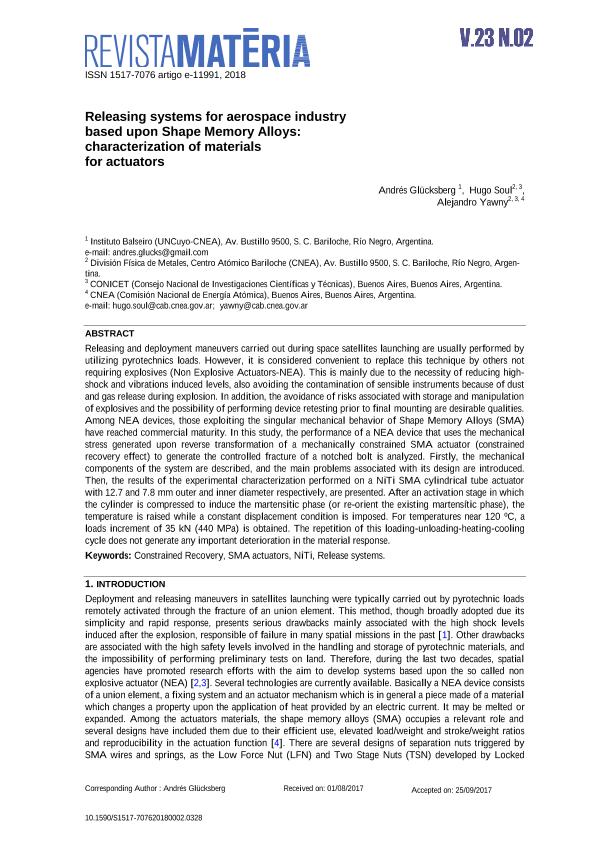Mostrar el registro sencillo del ítem
dc.contributor.author
Glücksberg, Andrés
dc.contributor.author
Soul, Hugo Ramon

dc.contributor.author
Yawny, Alejandro Andres

dc.date.available
2020-02-12T17:55:25Z
dc.date.issued
2018-07
dc.identifier.citation
Glücksberg, Andrés; Soul, Hugo Ramon; Yawny, Alejandro Andres; Releasing systems for aerospace industry based upon shape memory alloys: Characterization of materials for actuators; Universidade Federal do Rio de Janeiro; Matéria; 23; 2; 7-2018; 1-12
dc.identifier.issn
1517-7076
dc.identifier.uri
http://hdl.handle.net/11336/97284
dc.description.abstract
Releasing and deployment maneuvers carried out during space satellites launching are usually performed by utilizing pyrotechnics loads. However, it is considered convenient to replace this technique by others not requiring explosives (Non Explosive Actuators-NEA). This is mainly due to the necessity of reducing high-shock and vibrations induced levels, also avoiding the contamination of sensible instruments because of dust and gas release during explosion. In addition, the avoidance of risks associated with storage and manipulation of explosives and the possibility of performing device retesting prior to final mounting are desirable qualities. Among NEA devices, those exploiting the singular mechanical behavior of Shape Memory Alloys (SMA) have reached commercial maturity. In this study, the performance of a NEA device that uses the mechanical stress generated upon reverse transformation of a mechanically constrained SMA actuator (constrained recovery effect) to generate the controlled fracture of a notched bolt is analyzed. Firstly, the mechanical components of the system are described, and the main problems associated with its design are introduced. Then, the results of the experimental characterization performed on a NiTi SMA cylindrical tube actuator with 12.7 and 7.8 mm outer and inner diameter respectively, are presented. After an activation stage in which the cylinder is compressed to induce the martensitic phase (or re-orient the existing martensític phase), the temperature is raised while a constant displacement condition is imposed. For temperatures near 120 °C, a loads increment of 35 kN (440 MPa) is obtained. The repetition of this loading-unloading-heating-cooling cycle does not generate any important deterioration in the material response.
dc.format
application/pdf
dc.language.iso
eng
dc.publisher
Universidade Federal do Rio de Janeiro

dc.rights
info:eu-repo/semantics/openAccess
dc.rights.uri
https://creativecommons.org/licenses/by-nc-sa/2.5/ar/
dc.subject
CONSTRAINED RECOVERY
dc.subject
SMA ACTUATORS
dc.subject
NITI
dc.subject
RELEASE SYSTEMS
dc.subject.classification
Otras Ingeniería de los Materiales

dc.subject.classification
Ingeniería de los Materiales

dc.subject.classification
INGENIERÍAS Y TECNOLOGÍAS

dc.title
Releasing systems for aerospace industry based upon shape memory alloys: Characterization of materials for actuators
dc.type
info:eu-repo/semantics/article
dc.type
info:ar-repo/semantics/artículo
dc.type
info:eu-repo/semantics/publishedVersion
dc.date.updated
2019-10-15T17:57:18Z
dc.journal.volume
23
dc.journal.number
2
dc.journal.pagination
1-12
dc.journal.pais
Brasil

dc.description.fil
Fil: Glücksberg, Andrés. Comisión Nacional de Energía Atómica. Gerencia del Área de Energía Nuclear. Instituto Balseiro; Argentina
dc.description.fil
Fil: Soul, Hugo Ramon. Comisión Nacional de Energía Atómica. Centro Atómico Bariloche; Argentina. Consejo Nacional de Investigaciones Científicas y Técnicas; Argentina
dc.description.fil
Fil: Yawny, Alejandro Andres. Comisión Nacional de Energía Atómica. Centro Atómico Bariloche; Argentina. Consejo Nacional de Investigaciones Científicas y Técnicas; Argentina
dc.journal.title
Matéria

dc.relation.alternativeid
info:eu-repo/semantics/altIdentifier/doi/http://dx.doi.org/10.1590/s1517-707620180002.0328
dc.relation.alternativeid
info:eu-repo/semantics/altIdentifier/url/http://ref.scielo.org/k8hrth
Archivos asociados
